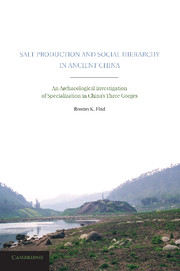 Salt Production and Social Hierarchy in Ancient China
Salt Production and Social Hierarchy in Ancient China Book contents
- Frontmatter
- Contents
- List of Figures and Tables
- Acknowledgments
- Prologue
- 1 Introduction
- 2 Production and Specialization in Complex Societies
- 3 Ancient Salt Production in Sichuan
- 4 The Zhongba Site
- 5 Ceramic Evidence
- 6 Parameters of Production According to Ceramics
- 7 Features and Spatiality
- 8 Animal Remains and Divination
- 9 Conclusions and Implications
- Epilogue
- Appendix A Chinese and Japanese Term List
- Appendix B The (t) Value and Average Thickness for Each Level Excavated in DT0202
- Appendix C Calculating the Scale of Production Using Briquetage from DT0202
- Appendix D Taxon List for Specimens Recovered from DT0202 with Number of Identified Specimens and Minimum Number of Individual Count by Phase and Subphase
- Notes
- Bibliography
- Index
7 - Features and Spatiality
Published online by Cambridge University Press: 07 September 2011
- Frontmatter
- Contents
- List of Figures and Tables
- Acknowledgments
- Prologue
- 1 Introduction
- 2 Production and Specialization in Complex Societies
- 3 Ancient Salt Production in Sichuan
- 4 The Zhongba Site
- 5 Ceramic Evidence
- 6 Parameters of Production According to Ceramics
- 7 Features and Spatiality
- 8 Animal Remains and Divination
- 9 Conclusions and Implications
- Epilogue
- Appendix A Chinese and Japanese Term List
- Appendix B The (t) Value and Average Thickness for Each Level Excavated in DT0202
- Appendix C Calculating the Scale of Production Using Briquetage from DT0202
- Appendix D Taxon List for Specimens Recovered from DT0202 with Number of Identified Specimens and Minimum Number of Individual Count by Phase and Subphase
- Notes
- Bibliography
- Index
Summary
At Zhongba, archaeological features such as pits, workshop floors, and kilns provide direct evidence of the spatial aspect of production at the site. By analyzing the spatial organization of production areas, we can observe the physical constraints placed on social interaction among producers as well as how the organization of space in activity areas changes over time and, in so doing, examine the strength of the spatial habitus that was both constitutive of and constituted by past social action. The degree to which features associated with production across the site share a rigid organization reflects the degree to which space at the site was managed and controlled by a segment of the population. Changes (or lack of changes) in this organization relate to the reconstitution or perpetuation of this organizing force.
In this chapter, I describe the various types of archaeological features discovered in the main activity area on the Zhongba mound. The purpose of this analysis is to examine the structured environment within which salt production and other related activities took place. I will discuss pits, kilns, workshop floors, and enigmatic features such as holes and gullies. In each case, I explore the possible functions of these various features and discuss some aspects of their spatial organization. We observe that starting in Phase II and continuing throughout Phase III, a remarkably consistent organization of space was observed in the Zhongba production area. The layout of this area and the consistency of its organization indicate strong traditions in the long-term development of salt production at Zhongba and also suggest some degree of centralized community oversight.
- Type
- Chapter
- Information
- Salt Production and Social Hierarchy in Ancient ChinaAn Archaeological Investigation of Specialization in China's Three Gorges, pp. 143 - 172Publisher: Cambridge University PressPrint publication year: 2011


